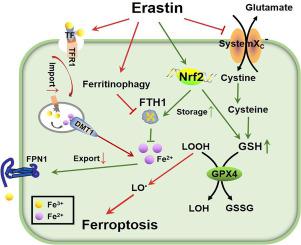Toxicology and Applied Pharmacology ( IF 3.3 ) Pub Date : 2020-09-13 , DOI: 10.1016/j.taap.2020.115241 Zixuan Liu 1 , Xuying Lv 1 , Erqun Song 1 , Yang Song 1

|
Neurological diseases were often characterized by progressive neuronal death, and emerging evidences suggested that ferroptosis may be an active driver of multiple neurodegenerative diseases. However, the mechanisms underlying ferroptosis in neuron cells are unclear. Here, we demonstrated that ferroptotic stimuli caused injury in neuron-like PC12 cells by modulating the expression of proteins involved in iron metabolism and lipid peroxidation at multiple levels, such as altering iron import/export, activating ferritinophagy, and decreasing glutathione (GSH) level. Nuclear factor erythroid 2-related factor 2 (Nrf2) regulates multiple genes involved in ferroptosis, however, its exact role remain elusive. Our mechanistic inquiry revealed that Nrf2 expression enhanced iron storage capacity by increasing ferritin heavy chain 1 (FTH1) expression in PC12 cells. Moreover, Nrf2 alleviated the decrease in GSH level by promoting the expression of genes related to GSH synthesis, including solute carrier family 7 member 11 (SLC7A11) and cysteine ligase (GCL). The contribution of Nrf2 on ferroptosis resistance was further verified by increasing cell tolerance to oxidative stress. Furthermore, Nfe2l2 (Nrf2) knockdown sensitized cells to ferroptotic cell death. Taken together, our findings suggested that iron accumulation caused by altering iron metabolism and the decrease of GSH content are key factors in determining ferroptosis in PC12 cells, and Nrf2 inhibits ferroptosis by combating iron-induced oxidative stress. Our present study provided new clues for the intervention and prevention against ferroptosis-associated neurological diseases.
中文翻译:

培育的Nrf2表达可拮抗铁超负荷和谷胱甘肽耗竭,从而促进神经元样细胞对肥大症的抵抗力。
神经系统疾病通常以进行性神经元死亡为特征,新出现的证据表明,肥大症可能是多种神经退行性疾病的积极驱动因素。但是,尚不清楚神经元细胞中促肥大作用的机制。在这里,我们证明了铁蛋白体刺激通过在多个水平上调节铁代谢和脂质过氧化作用中涉及的蛋白质的表达来调节神经元样PC12细胞的损伤,例如改变铁的进出口,激活铁蛋白吞噬和降低谷胱甘肽(GSH)的水平。 。核因子红系2相关因子2(Nrf2)调节了与肥大病有关的多个基因,但是,其确切作用仍然难以捉摸。我们的机理研究表明,Nrf2表达通过增加PC12细胞中铁蛋白重链1(FTH1)的表达来增强铁的储存能力。此外,Nrf2通过促进与GSH合成相关的基因(包括溶质载体家族7成员11(SLC7A11)和半胱氨酸连接酶(GCL))的表达来减轻GSH水平的降低。通过增加细胞对氧化应激的耐受性,进一步证实了Nrf2对抗铁锈病的贡献。此外,Nfe2l2(Nrf2)敲低敏细胞对促肥性细胞死亡。综上所述,我们的发现表明,由铁代谢改变和GSH含量降低引起的铁蓄积是决定PC12细胞肥大的关键因素,Nrf2通过对抗铁诱导的氧化应激来抑制肥大。我们的研究为干预和预防与勃起病相关的神经系统疾病提供了新的线索。





















































 京公网安备 11010802027423号
京公网安备 11010802027423号